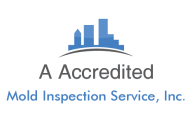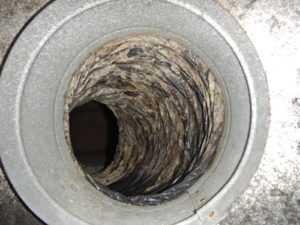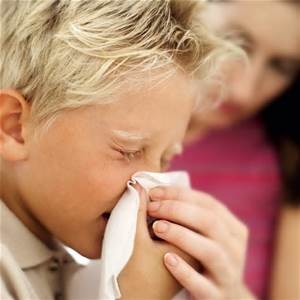All about AC Duct Mold.
Information on Mold Inside AC Units & Ducts
FIVE QUESTIONS
The five most common questions related to AC unit mold or AC duct mold, and answers from our West Palm Beach mold inspector.
Information is below. If you need an AC mold inspection in the West Palm Beach, Miami, or Ft Lauderdale area give us a call at 1888-381-6681.
1) Is AC duct mold bad mold and can it make me sick?
2) Can AC mold be cleaned?
3) How do I clean my ducts?
4) Do you know a good duct cleaning company?
5) What kind of mold typically grows inside AC units and AC ducts?
The Answer
Is AC duct mold bad mold?
-Yes
Based on doing mold inspections in many South Florida homes and commercial buildings since 2004,
I can tell you that the mold inside AC systems and ducts is typically Cladosporium mold. It can make many people sick. It may not be what people call toxic-mold, but it does very often cause other non-toxic types of health complaints like allergy and asthma, sometimes serious. Even toxic mold typically does not appear to often cause toxic reactions in indoor contamination settings.
Can AC Mold be Cleaned?
– Yes
Professional duct cleaning, and air conditioner system cleaning should be implemented if they are moldy.
Problems with Duct Cleaning
One common problem is that people will give you a low price by giving a quote on duct cleaning only, or coil cleaning only, or air handler cleaning only.
In most cases it is best to get the entire HVAC system including the ducts and AC cleaned. The humid dusty conditions that caused microbial growth in one section of your AC likely caused growth in many other sections as well so get the entire system and all components cleaned.
Another difficulty with duct cleaning is that people often do not do it right. A few weeks ago I did an AC duct mold inspection in West Palm Beach Florida where the ducts were supposed to have been cleaned and they were not. And yesterday I did a similar inspection in Palm Beach Gardens where the ducts were supposed to be cleaned. The clients were ripped off in each case because the ducts were never cleaned. In each case the clients went back to the duct cleaning companies and used our reports and requested that either the ducts be re-cleaned or the money be re-funded.
Unfortunately, ducts might not be cleanable if they are overly moldy. It may be best to replace your ducts if mold is impregnated deep inside fiberglass ducts.
How Do I Clean My Ducts?
- Pick up your brush, googles, dust mask, and spray bottle.
- Put them all away in a toolbox.
- Pick up the phone and call a professional.
Do not under any circumstance try to clean a moldy air conditioner system, or moldy ducts yourself. Some handy people get away with minor cleaning jobs, but I am going to recommend you not try it.
A professional AC serviceperson should be hired for duct cleaning.
The Problems with Do It Yourself AC Cleaning
You will bend your moldy evaporator coil fins if you attempt to brush them.
You will stir up more mold spores than you remove if you try and clean your ducts.
It is very important to understand that you will never be able to reach most of your duct area.
Also, a severe electrical shock is a real danger from the capacitor even if you turn off the AC breaker.
Call a professional for mold removal. Also, after cleaning, a UV Light can be installed to deter molds return. I have recommended UV light instillation in AC units to my clients for years. Never look at a UV light when it is on, they are bad for your eyes.
Do I Know a Good Duct Cleaning Company?
-No
I have recommended many over the years, however, proper cleaning is not easy and they have often failed. I cannot easily recommend a good duct cleaning company.
But:
IAQA.org
and
ACAC.org
are very good places to start your own search at your own risk.
What kind of mold typically grows inside AC units and AC ducts?
This mold is often grey or black, it may have white patches. It is not likely the one they call toxic black mold. All that grey, black, and white stuff in AC units and ducts is almost always primarily Cladosporium mold. Smaller amounts of Pen Asp mold and other molds may be present in the AC unit and ducts as well. But based on countless inspections for the last many years it is primarily Cladosporium mold in air conditioner systems and ducts.
Cladosporium mold inside a flex round AC duct. Might not be very toxic but it may release foul smelling MVOCs that cause severe allergy and asthma reactions.
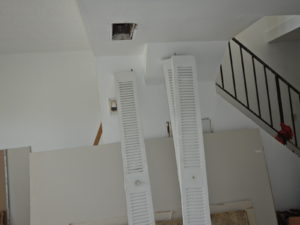
See the tiny black square at the top center of this image? Its the opening to a very moldy duct in a Miami duplex I inspected.
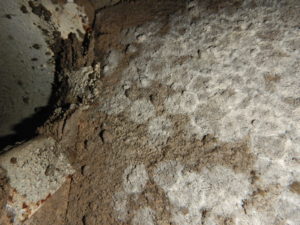
Closer view in same duct. Extremely moldy duct interior. Note the grey and white Cladosporium mold as discusses in our article.
The mold inside AC units is very often Cladosporium mold. This mold most often appears tan, grey, or white inside ducts. It is often pure dark black on AC register and on the exterior of air handers and outdoors where it is exposed to light.
Helpful Tip:
UV lights can help prevent mold growth in the exact areas where they are installed. I have recommended them to my clients for years.
They control microbial growth in your air handlers most vulnerable areas. The areas where AC mold control is most needed at the supply plenum, the return plenum, and the bottom of the coils.
Just make sure you get one that does not produce ozone.
Cladosporium Molds Preferred Ecological Niche
The interior of AC units and ducts provides the perfect conditions for Cladosporium mold growth.
That musty smell inside AC ducts is typically from Cladosporium mold metabolizing foods such as dust and releasing smelly gaseous waste products from your AC ducts. Some people refer to it as a dirty sock odor.
Why Are Ducts and Air Handler units Cladosporium Molds Preferred Ecological Niche?
Cladosporium does not require much cellulose. Cellulose is a complex carbohydrate originating in woody plants like trees. Cladosporium very commonly grows in areas with no cellulose content like on metal, wire insulation, and fiberglass. I do not know of any other mold that is so adapted to cellulose free environments. These man-made cellulose free materials are all found deep inside AC units and this is why Cladosporium can survive in AC units where other mold cannot compete. In these harsh, nutrient poor, man-made environments, Cladosporium does not have to compete with other molds.
How Do I Know All This?
I have conduct home mold inspections and AC unit mold inspections from Miami to West Palm Beach since 2004. Having provided these mold relates services I see a pattern. Almost all the mold in almost all ducts and AC units sampled is Cladosporium.
The Problem with Cladosporium Mold Inside AC Systems.
One of the most underrated mold issues in homes today is Cladosporium mold in AC units.
Despite it being an extremely common problem, many inspectors overlook it because they do not open AC units, or remove the filter, or smell the air coming out of ducts during mold inspections. Inspectors often get distracted by taking samples and forget to look for mold wherever it grows.
Because it cannot be seen, many homeowners ususally don’t know it is present. However, it is still a serious issue that must be properly confirmed and diagnosed by a trained AC unit mold inspector.
First a problem is confirmed to be present, or not present by a non-bias mold inspector.
Next, if a problem is present, then you can get someone in to remove it.
